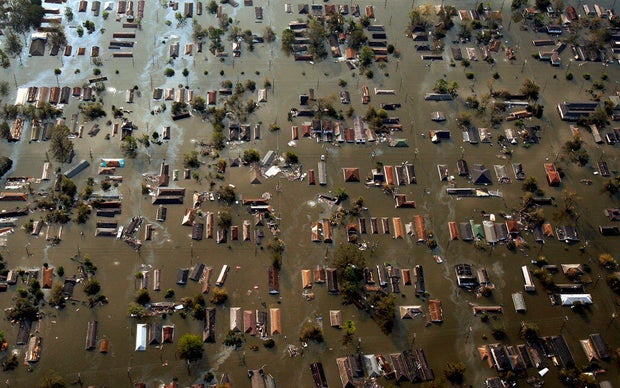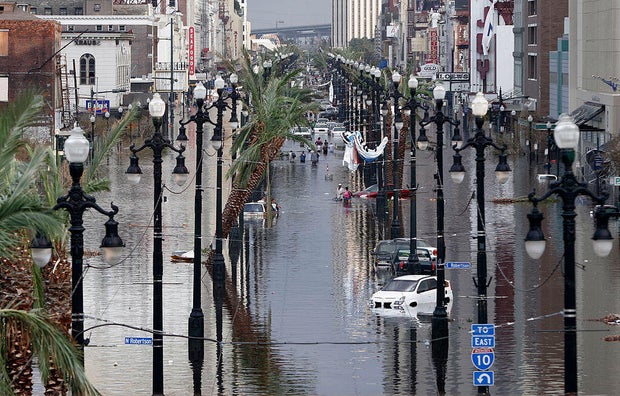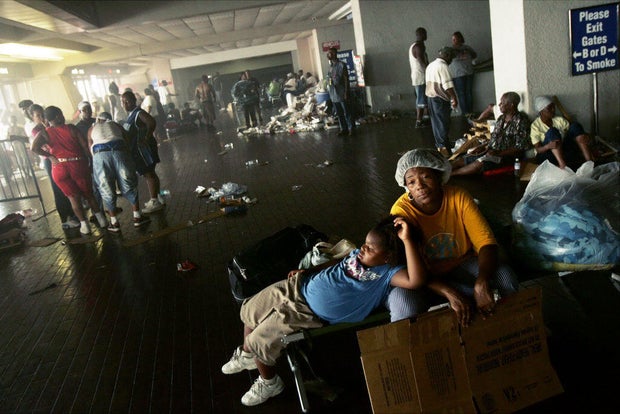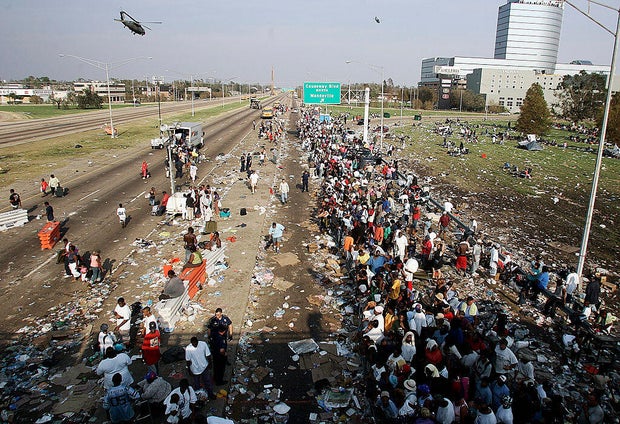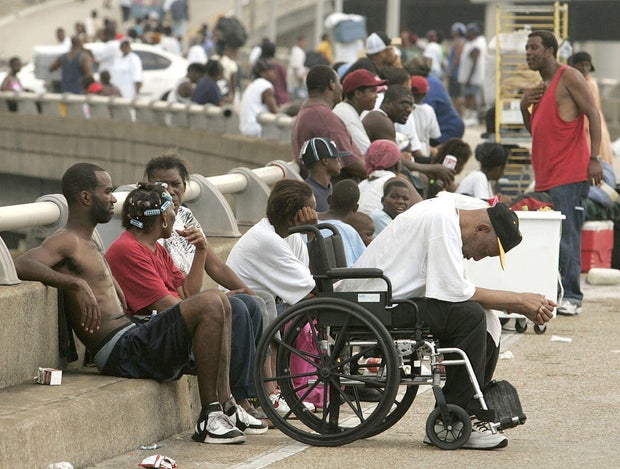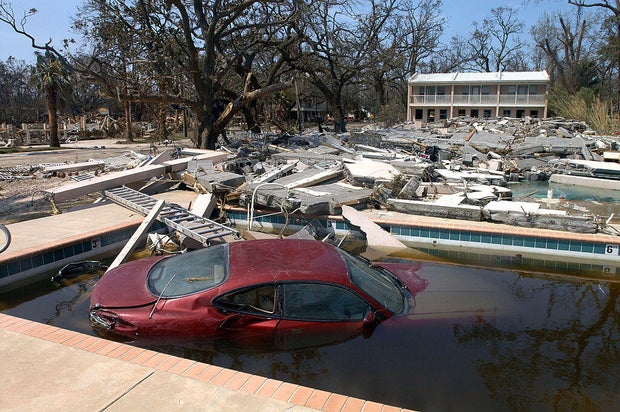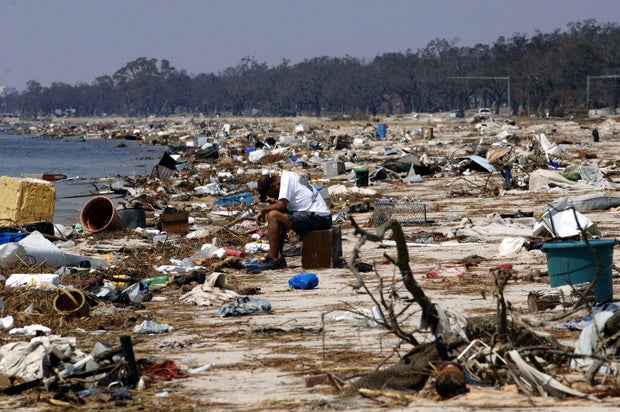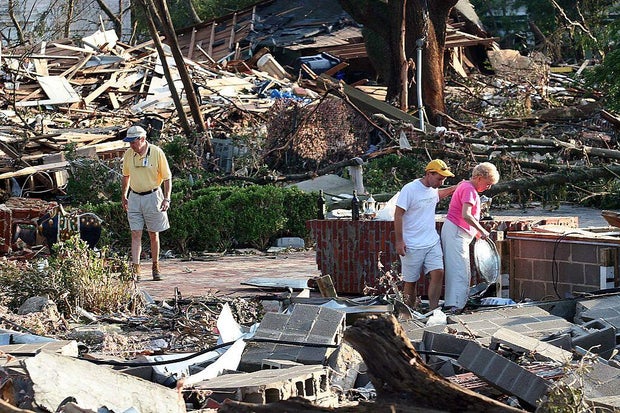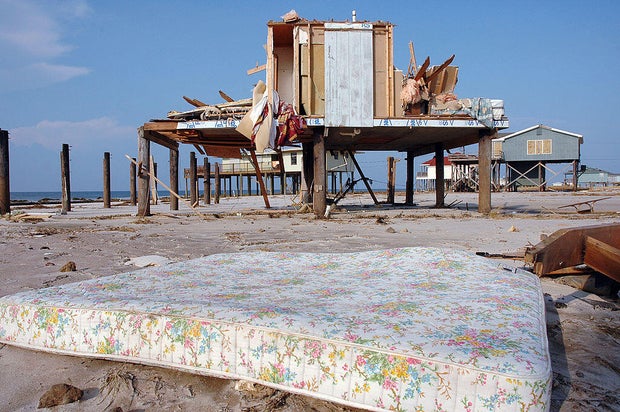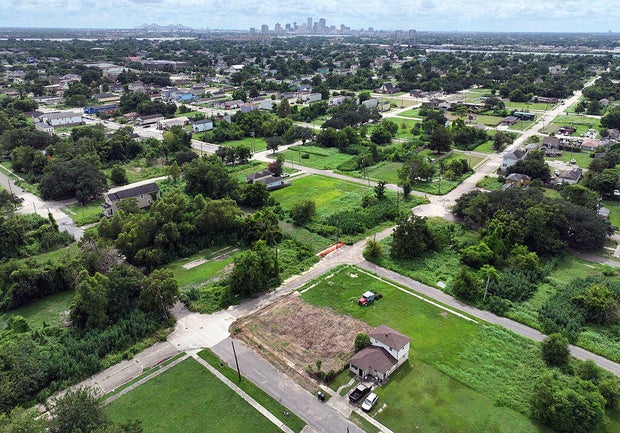Hurricane Katrina was described as “a slow-motion catastrophe” on “60 Minutes” on Sept. 4, 2005, six days after slamming the Gulf Coast. Twenty years later, the storm is known as the costliest and one of the deadliest to ever hit the United States.
Katrina first made landfall as a Category 1 storm in Florida on Aug. 25, 2005. It then intensified to a Category 5 hurricane in the Gulf. Weakening to a Category 3, it made landfall again on Aug. 29, 2005, in southeast Louisiana and then in Mississippi.
While the toll didn’t become clear for days, the storm ultimately led to nearly 1,400 deaths, the majority in New Orleans, according to the National Hurricane Center.
Universal History Archive/Universal Images Group via Getty Images
Initial reports suggested the damage in New Orleans wasn’t worse than past hurricanes the city had weathered — until the levees failed.
“That’s when all hell broke loose, when all the water started inundating the city,” Eddie Compass, the New Orleans Police superintendent at the time, told CBS News in a recent interview. “That’s when we knew we had something that was much different than a regular hurricane.”
At least 80% of New Orleans was flooded. Roads were impassable without boats, and people were stranded on roofs.
AFP PHOTO/POOL/Vincent Laforet via Getty Images
Smiley N. Pool/Houston Chronicle via Getty Images
Thousands of people had taken shelter in New Orleans’ Superdome ahead of the storm, but became trapped there for days with limited food and water when the city flooded.
Thousands more ended up on the interstate after escaping rising waters. They were stuck in the heat with no help for days.
Many weren’t able to evacuate ahead of time.
“We don’t have transportation. I mean, we’re living paycheck-to-paycheck,” one woman told CBS News as she stood on the side of the highway on Aug. 30, 2005.
Chris Graythen / Getty Images
Marko Georgiev / Getty Images / Marko Georgiev/Contributor
Vincent Laforet/POOL/AFP via Getty Images
Michael Appleton/NY Daily News Archive via Getty Images
The federal response to New Orleans was harshly criticized for taking too long. It was three days before the National Guard arrived.
When then-Army Lt. Gen. Russel Honoré — who led the military response and has been credited for bringing calm to a chaotic situation — arrived in New Orleans, he faced a humanitarian crisis.
“I saw people waiting to be evacuated. I saw elderly people on the sidewalk. I saw women with babies there,” he told “CBS Evening News” co-anchor Maurice DuBois.
Mario Tama/Getty Images
Mario Tama / Getty Images
Paul Morse/White House via Getty Images
Search and rescue operations and evacuations were hindered by several factors, including a broken communications grid, Honoré said in an interview with CBS News.
“Katrina overmatched the infrastructure. It broke the communications grid,” he said. “So that was a major challenge to find out exact situation reports, and many people in Baton Rouge and at the federal government were getting their information from watching television.”
An exaggerated picture of lawlessness also complicated the situation, Honoré said.
“This ended up being a major evacuation operational logistics issue, which was distracted by many political-inspired news that this was a looting problem and not an evacuation problem,” he said.
David J. Phillip/POOL/AFP via Getty Images
Keith Birmingham/MediaNews Group/Pasadena Star-News via Getty Images
Mark Wilson / Getty Images
Storm surge from Katrina also devastated parts of Mississippi and Alabama. Images showed buildings reduced to rubble and debris across the coast.
One man in Gulfport, Mississippi, recounted to CBS News days after the storm hit how he stood on his stove as water filled his kitchen.
Barry Williams / Getty Images
Marianne Todd / Getty Images
Oscar Sosa/Bloomberg via Getty Images
Kari Goodnough/Bloomberg via Getty Images
Today, some communities, including Dauphin Island, Alabama, are still fighting to protect themselves from the next disaster.
Residents of New Orleans’ Lower Ninth Ward, a predominantly Black community that was fully inundated when the flood wall broke, say the historic neighborhood has never returned to what it was before Katrina.
“We’re the land they forgot about. We’re the last ones to get our streets fixed, the last ones to get any kind of help from the city. If you come through here at night it’s dark — there’s no street signs, no working stop signs, there’s nothing down here. Two stores and one elementary school in the whole neighborhood, when there used to be tons of resources,” Ethelynn and Michael Vaughn told Getty Images.
Another resident, Frank Parker, said the neighborhood “still looks like a dead zone.”
Mario Tama / Getty Images
Brandon Bell / Getty Images
Brandon Bell / Getty Images
Brandon Bell / Getty Images
contributed to this report.
Hurricane Katrina was described as “a slow-motion catastrophe” on “60 Minutes” on Sept. 4, 2005, six days after slamming the Gulf Coast. Twenty years later, the storm is known as the costliest and one of the deadliest to ever hit the United States.Katrina first made landfall as a Category 1 storm in Florida on Aug. 25, 2005. It then intensified to a Category 5 hurricane in the Gulf. Weakening to a Category 3, it made landfall again on Aug. 29, 2005, in southeast Louisiana and then in Mississippi.While the toll didn’t become clear for days, the storm ultimately led to nearly 1,400 deaths, the majority in New Orleans, according to the National Hurricane Center.
A satellite image shows Hurricane Katrina as it approached the Gulf Coast in August 2005.
Universal History Archive/Universal Images Group via Getty Images
Initial reports suggested the damage in New Orleans wasn’t worse than past hurricanes the city had weathered — until the levees failed. “That’s when all hell broke loose, when all the water started inundating the city,” Eddie Compass, the New Orleans Police superintendent at the time, told CBS News in a recent interview. “That’s when we knew we had something that was much different than a regular hurricane.”At least 80% of New Orleans was flooded. Roads were impassable without boats, and people were stranded on roofs.
Flood waters from Hurricane Katrina cover streets on Aug. 30, 2005, in New Orleans, Louisiana.
AFP PHOTO/POOL/Vincent Laforet via Getty Images
An aerial view shows water surrounding homes in New Orlean’s devastated Ninth Ward on Aug. 30, 2005.
Smiley N. Pool/Houston Chronicle via Getty Images
Thousands of people had taken shelter in New Orleans’ Superdome ahead of the storm, but became trapped there for days with limited food and water when the city flooded.
Thousands more ended up on the interstate after escaping rising waters. They were stuck in the heat with no help for days. Many weren’t able to evacuate ahead of time. “We don’t have transportation. I mean, we’re living paycheck-to-paycheck,” one woman told CBS News as she stood on the side of the highway on Aug. 30, 2005.
Canal Street is flooded a day after Hurricane Katrina blew through New Orleans.
Chris Graythen / Getty Images
Lower Ninth Ward residents stranded on the roofs wait for rescue boats in New Orleans on Aug. 29, 2005.
Marko Georgiev / Getty Images / Marko Georgiev/Contributor
People are stranded on a roof due to flood waters from Hurricane Katrina on Aug. 30, 2005, in New Orleans, Louisiana.
Vincent Laforet/POOL/AFP via Getty Images
People driven from their homes by Hurricane Katrina rest atop their belongings as they wait to be evacuated from the Superdome in New Orleans.
Michael Appleton/NY Daily News Archive via Getty Images
The federal response to New Orleans was harshly criticized for taking too long. It was three days before the National Guard arrived.
When then-Army Lt. Gen. Russel Honoré — who led the military response and has been credited for bringing calm to a chaotic situation — arrived in New Orleans, he faced a humanitarian crisis. “I saw people waiting to be evacuated. I saw elderly people on the sidewalk. I saw women with babies there,” he told “CBS Evening News” co-anchor Maurice DuBois.
Two men paddle in high water on Aug. 31, 2005, after Hurricane Katrina devastated New Orleans, Louisiana.
Mario Tama/Getty Images
Survivors of Hurricane Katrina walk to high ground on a highway after being evacuated from the flooding in New Orleans.
Mario Tama / Getty Images
In this handout photo provided by the White House, President George W. Bush looks out over devastation from Hurricane Katrina as he heads back to Washington, D.C., on Aug. 31, 2005, aboard Air Force One.
Paul Morse/White House via Getty Images
Search and rescue operations and evacuations were hindered by several factors, including a broken communications grid, Honoré said in an interview with CBS News. “Katrina overmatched the infrastructure. It broke the communications grid,” he said. “So that was a major challenge to find out exact situation reports, and many people in Baton Rouge and at the federal government were getting their information from watching television.”An exaggerated picture of lawlessness also complicated the situation, Honoré said.”This ended up being a major evacuation operational logistics issue, which was distracted by many political-inspired news that this was a looting problem and not an evacuation problem,” he said.
Residents are rescued by helicopter from the floodwaters of Hurricane Katrina on Sept. 1, 2005, in New Orleans, Louisiana.
David J. Phillip/POOL/AFP via Getty Images
Thousands of people displaced by Hurricane Katrina wait to be taken to safety during a helicopter pickup on Interstate 10 in New Orleans, Louisiana, on Sept. 2, 2005.
Keith Birmingham/MediaNews Group/Pasadena Star-News via Getty Images
Thousands of people sit on the freeway after fleeing to higher ground Aug. 31, 2005, after Hurricane Katrina devastated New Orleans.
Mark Wilson / Getty Images
Storm surge from Katrina also devastated parts of Mississippi and Alabama. Images showed buildings reduced to rubble and debris across the coast.
One man in Gulfport, Mississippi, recounted to CBS News days after the storm hit how he stood on his stove as water filled his kitchen.
A car is seen in a beachfront pool on Aug. 30, 2005, in Biloxi, Mississippi, after Hurricane Katrina hit.
Barry Williams / Getty Images
A man spends a quiet moment on the once pristine stretch of beach in Biloxi, Mississippi, on Sept. 2, 2005.
Marianne Todd / Getty Images
Ben Stone and his wife Nancy look through the remains of their home with their son-in-law, Terry Robinson, center, after Hurricane Katrina destroyed their home in Gulfport, Mississippi.
Oscar Sosa/Bloomberg via Getty Images
A beach home on the west end of Dauphin Island, Alabama, in the Gulf is left in pieces on Sept. 1, 2005, in the wake of Hurricane Katrina.
Kari Goodnough/Bloomberg via Getty Images
Today, some communities, including Dauphin Island, Alabama, are still fighting to protect themselves from the next disaster. Residents of New Orleans’ Lower Ninth Ward, a predominantly Black community that was fully inundated when the flood wall broke, say the historic neighborhood has never returned to what it was before Katrina.”We’re the land they forgot about. We’re the last ones to get our streets fixed, the last ones to get any kind of help from the city. If you come through here at night it’s dark — there’s no street signs, no working stop signs, there’s nothing down here. Two stores and one elementary school in the whole neighborhood, when there used to be tons of resources,” Ethelynn and Michael Vaughn told Getty Images. Another resident, Frank Parker, said the neighborhood “still looks like a dead zone.”
An aerial view of rebuilt homes amid vacant lots where homes once stood in the Lower Ninth Ward on Aug. 10, 2025 in New Orleans, Louisiana.
Mario Tama / Getty Images
Frank Parker at his home in the Lower Ninth Ward on Aug. 27, 2025 in New Orleans, Louisiana.
Brandon Bell / Getty Images
Ethelynn and Michael Vaughn stand for a portrait at their home in the Lower Ninth Ward on Aug. 26, 2025 in New Orleans, Louisiana.
Brandon Bell / Getty Images
A mural is displayed on a levee wall in the Lower Ninth Ward on Aug. 25, 2025, in New Orleans, Louisiana.
Brandon Bell / Getty Images
Kati Weis
contributed to this report.
Remembering Katrina
More
Nicole Brown Chau
Nicole Brown Chau is a deputy managing editor for CBSNews.com. She writes and edits national news, health stories, explainers and more.
Adblock test (Why?)
Home – CBSNews.com




